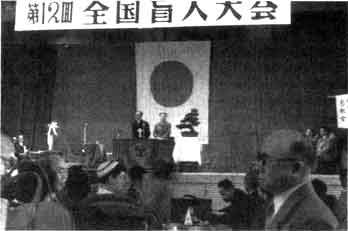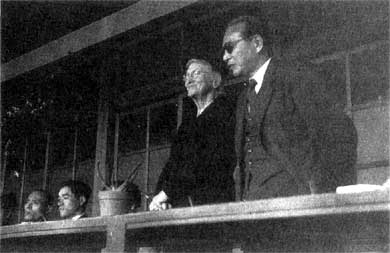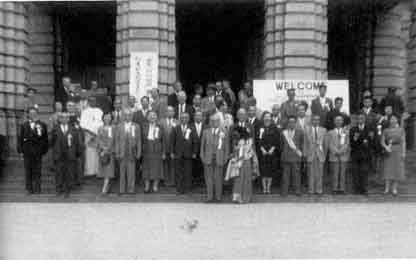
|
Traces That Remain:
A Pictorial History of the Early Days of the Bahá'í Faith among the Japanese
by Barbara R. Sims
edited by Sheridan Sims  |
chapter 59 | start page | single page | chapter 61 |  |
Chapter 60
One of the earliest conferences after World War II was a three day religious conference held in Tokyo, September 1848. Mr. Goro Horioka, a Tokyo Bahá'í, spoke on the Faith during the last day of the conference.
After Miss Alexander returned to Japan, 1950, she continued to seek out opportunities to teach the Faith. In January 1952 she spoke at a meeting in Tokyo celebrating the third Annual World Religion Day. The meeting, which was sponsored by the Tokyo Local Spiritual Assembly was held at the YMCA. Announcements were put in both English and Japanese papers and information about the meeting was broadcast over NHK (the national radio network.) Mr. Horioka was chairman and Mr.

click here for larger image
World Religion Day meeting in Tokyo, 1952. About thirty people attended. Miss Alexander is speaking with Mr. Hongo translating.
Another conference in 1952 was the World Federalist Conference in Hiroshima. Miss Alexander officially represented the Bahá'í Faith. She said it was the Plan of God that she was seated next to a Chinese-Malaysian man who had come to Japan to attend the conference. Mr. Yan Kee Leong had heard of the Faith from Mrs. Shirin Fozdar in Malaysia, then called Malaya. He was greatly attracted to Miss Alexander and he felt she had the Truth. Shortly after he returned to Malaya he became a Bahá'í; the first Malayan Bahá'í. He was also the first Bahá'í of Chinese ancestry to be appointed as counsellor by the Universal House of Justice, some years later. He always felt a kinship with Japan and visited several times in subsequent years.
Miss Alexander spoke several times at the Japanese Unitarian church in Tokyo through her connections made years earlier.
In 1955 a Conference of World Religionists was held in Tokyo with some sessions in other cities. Dr. David Earl was the official Bahá'í representative. Three Bahá'ís attended every day, including Miss Alexander and Mr. Marangella. The Faith was brought to the attention of some two hundred religious leaders

click here for larger image
Conference of World Religionists, August 1955. Three Bahá'ís attending various sessions are seen in this newspaper clipping. Mr. Marangella is in the middle, Dr. Earl, seen in profile, and Miss Alexander.
International Congress of World Fellowship of Faiths, Tokyo, October 1956. Miss Alexander is in the first row a little to the left. Several other Bahá'ís can be seen also. The photograph was taken after the second session.This building, fashioned after the Palace of Versailles, was later closed to general public gatherings and reserved for Heads of State.
A meeting of the International Congress of World Fellowship of Faiths was held in Tokyo, October 1956. According to a booklet issued after the Congress, it was the tenth in a series of conferences, the first of which was the Parliament of Religions, Chicago, 1893, where the Bahá'í Faith was first mentioned publicly

click here for larger image
The 12th National Conference for the Blind, Matsue, 1959. Miss Alexander is speaking with Mr. Torii translating.Regarding that particular trip to Matsue, Miss Alexander wrote, "In Matsue City, the 12th Annual Conference of the Blind Association was held. Through our brother, Mr. Tokujiro Torii, who is president of the Blind Association, I was given the privilege of speaking at the close of the conference for three minutes. It was translated into Japanese. Four hundred representatives from forty-six prefectures were present.
"The time was short but after every translation there was tremendous applause."
Miss Alexander stated that she had known Mr. Torii for forty years; that she was a Bahá'í; that the sight of the eyes was not the most important, but the sight of the heart was the all important; that everyone longed for peace but it could only come through the spiritual unity of all people.
While she was speaking she noticed that a man holding bright lights was standing in front of them. It was NHK (Nihon Hoso Kyokai) Television Network. Miss Alexander stated, "This was shown throughout Japan giving prominence to the Faith."
It was the second time the Faith was mentioned on television.
The Congress in Tokyo was opened by the Vice President of India, Dr. S. Radhakrishnan. Bahá'ís had been invited to participate and were represented on the program by Mr. Philip Marangella and Lt. Lawrence Hamilton. Miss Alexander and some twelve other Bahá'ís attended various sessions. Twenty-one different countries were listed as being represented, with three hundred and fifty people attending the first day.
In 1959, the Ladies Society for Aid to the Blind held a concert in Tokyo, which was recorded for later radio broadcast. A

This photograph was in Miss Alexander's effects. She did not label it, so we do not know the occasion. However, it seems rather typical. Miss Alexander often accompanied Mr. and Mrs. Torii to both Esperanto and Blind Association conferences.In both types of events she was usually able to speak publicly, in English or Esperanto, with Mr. Torii translating. This photograph was taken during one such conference, probably one of the Blind Association in the late 1950s or early 1960s. In those early days foreigners were somewhat of a novelty in Japan and Miss Alexander often attracted attention and people listened to what she had to say.

click here for larger image
Esperanto Congress in Nagoya, May 1965. In the top photograph Miss Alexander is seen sitting among the participants. In the bottom one she is speaking to the Congress. An old friend, Mr. Kataoka is translating.Miss Alexander stayed as active as possible in Esperanto activities even through the later years. She felt that Esperantists were particularly receptive to the Faith.
This was the last Esperanto Congress she was able to attend. She came to Tokyo two months later to attend another one but before it opened she fell and broke her hip. She was hospitalized from then on.
In 1963 there was a conference of World Federalists in Tokyo. Mr. Finley Hollinger from the United States represented the Bahá'ís.
The World Conference on Religion and Peace, October 1970, in Kyoto was an important one. Mr. Glenford Mitchell, secretary of the National Spiritual Assembly of the Bahá'ís of the United States, was a delegate. Mrs. Shirin Fozdar was the Bahá'í delegate from Thailand. Dr. Toshio Suzuki, secretary of the National Spiritual Assembly of the Bahá'ís of North East Asia, was listed as an official observer from Japan. Three hundred delegates from more than one hundred and twenty-five countries attended. The three Bahá'ís mentioned had their photographs and biographies, in both English and Japanese, printed in the brochure which was distributed to all attendants.

click here for larger image
World Conference on Religion and Peace, Kyoto, October 1970. This photograph shows the Bahá'í representatives at the conference: Mrs. Shirin Fozdar, Mr. Glenford Mitchell, Dr. Toshio Suzuki and Mr. Rouhollah Mumtazi.
 |
chapter 59 | start page | single page | chapter 61 |  |
|
|
